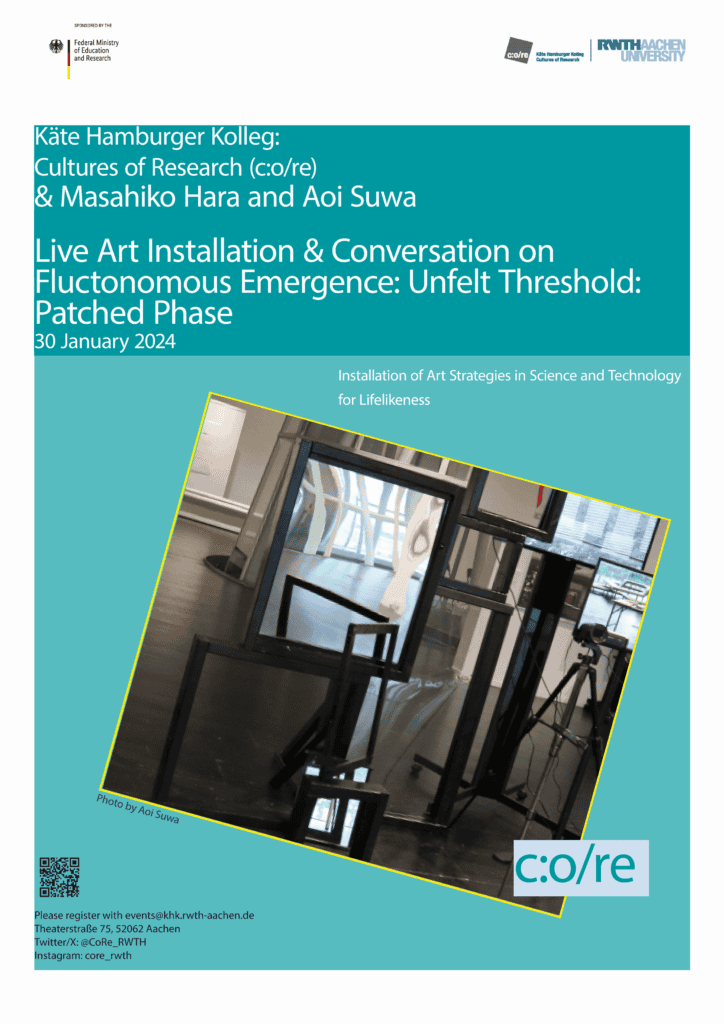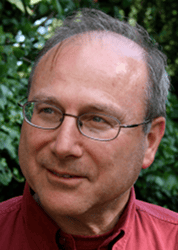Unfelt Treshold: Art Installation & Conversation on Fluctonomous Emergence
Unfelt Threshold is a project in which Japanese artist Aoi Suwa is indirectly linking together various pieces of objects and images, exhibiting the creations that she has produced over the years. As part of the project, c:o/re Senior Fellow Masahiko Hara and Aoi Suwa will stage a live installation at RWTH Aachen University’s Käte Hamburger Kolleg: Cultures of Research (c:o/re) and engage in a conversation on “Fluctonomous Emergence”, a term coined by Masahiko Hara. His research focuses on the integration of art strategies in science and technology and introduces a new concept of natural intelligence based on the emergent functions of autonomous ambiguous systems that exhibit fluctuant behavior.
This project stems from the concept of “shiki-ik” (識閾, the threshold of consciousness), the boundary where sensations and reactions occur in response to stimuli. The threshold through which transitions occur from the unconscious to the conscious, and vice versa, is the gateway of shifting between consciousness and unconsciousness.
Aoi Suwa continues to employ experimental techniques to create works focused on phenomena that can only be witnessed in situ, developing what could be described as an approach aimed at perceiving thresholds that emerge through the process of traversing back and forth between the realms of the perceivable/imperceivable and conscious/unconscious.
Through this project, we would like to explore its potential as a means of expressing the complexity and the lifelikeness of our current age and seek to reconsider our sustainable social systems surrounded by both living and non-living systems.
The installation can be viewed until 22 February 2024 by prior registration with events@khk.rwth-aachen.de.

Get to know our fellows: Nikita Braguinski
Get to know our current fellows and gain an impression of their research.
In a new series of short videos, we asked them to introduce themselves, talk about their work at c:o/re, the impact of their research on society and give book recommendations.
You can now watch the fourth video of the music and media scientist Dr. Nikita Braguinski on our Youtube channel:
Check out our Media section or our YouTube channel to have a look at the other videos.
Alexander von Humboldt Fellowship for Giora Hon

c:o/re short term fellow Prof. Dr. Giora Hon has been awarded with an Alexander von Humboldt Fellowship (Renewed Research Stay) for the period from 1 January to 31 March 2024, which gives him the opportunity to continue working on his research while staying in the research environment of c:o/re in Aachen.
During the fellowship, Giora Hon will work on his project entitled “A History of the Concept of Model”: How were models, designed as didactic devices, transformed into tools of research? A philosophical analysis of this fundamental change in the late nineteenth century will be the focus of this research stay.
We congratulate Giora on the fellowship and look forward to further cooperation, for example the organization of a workshop on concept formation in May 2024. Stay tuned!

Objects of Research: Alin Olteanu

Today, c:o/re post-doc and publications coordinator Alin Olteanu shares a picture of an object sitting on his desk in the c:o/re office. He is currently researching the social and cultural consequences of digitalization.
“The 3D replica of my teeth that stands on my desk reminds me of two important things. First, a model is what we make of it. The epistemic value of modelling lies in interpretation, which depends on but is not defined by representation. I make something very different of (a replica of) teeth than a dentist and an archaeologist do.
Secondly, and not any less important, this replica reminds me to smile, and I hope that it might inspire colleagues to smile, too, when they see it on my desk.
To tell a smile from a veil, as Pink Floyd ask us to, we need to know that a smile is infinitely more important than scientific modelling. If scientific modelling does not lead to smiling, it is of no value. A smile is a good metonymy to be reminded by.”

Would you like to find out more about our Objects of Research series at c:o/re? Then take a look at the pictures by Benjamin Peters, Andoni Ibarra and Hadeel Naeem.
Get to know our fellows: Hadeel Naeem
Get to know our current fellows and gain an impression of their research.
In a new series of short videos, we asked them to introduce themselves, talk about their work at c:o/re, the impact of their research on society and give book recommendations.
You can now watch the third video of the philosopher Hadeel Naeem on our Youtube channel:
Objects of Research: Hadeel Naeem

For today’s edition of our “Objects of Research” series, we interviewed c:o/re Junior Fellow Hadeel Naeem. Her current research focuses on how to responsibly extend the mind with AI systems and therefore acquire extended knowledge.
“A pen and a notebook are essential for my research. They help me think. It’s not at all about the words I write. I rarely read them again. Scribbling is just an act that helps me stack ideas on top of each other and do all the complicated thinking and connection-building.
I also turn to scribbling in my notebook when I am stuck in the writing process. There is often a time after the first rough draft of the paper when some ideas stop flowing smoothly or don’t fit very well with the main argument. I turn to the notebook and start writing the main ideas, deliberating how they support each other.
This is all especially interesting since a lot of my research is about extended cognition, which is the idea that we sometimes employ external resources such that part of our thinking happens outside our body (in these resources).”

Call for Abstracts: Workshop on “Participation and STS sensibilities: taking stock and moving forward”
Interested scholars are invited to submit abstracts for the workshop “Participation and STS sensibilities: taking stock and moving forward”. This workshop aims to explore what taking STS sensibilities seriously would mean for conceiving, understanding, practicing, and valuing public participation.
Keynote speaker: Professor Jason Chilvers (University of East Anglia)
Date: 23 May 2024
Location: Maastricht, The Netherlands
Abstract submission: abstracts (500 words) can be submitted here by 15 January 2024.
The workshop is organized by Care and Public Health Institute (Maastricht University, The Netherlands) with support of The Käte Hamburger Kolleg: Cultures of Research and Human Technology Center (RTWH Aachen University, Germany) and Spiral Research Centre (University of Liege, Belgium).
More information on the workshop theme can be found on the website: https://www.inpart-project.com/news/participation-and-sts-sensibilities-workshop/
Feel free to contact Olga Zvonareva (o.zvonareva@maastrichtuniversity) and Natasa Stoli (a.stoli@maastrichtuniversity) with any questions.
Get to know our fellows: Hans Ekkehard Plesser
Get to know our current fellows and gain an impression of their research.
In a new series of short videos, we asked them to introduce themselves, talk about their work at c:o/re, the impact of their research on society and give book recommendations.
You can now watch the second video of the neuroscientist Hans Ekkehard Plesser on our Youtube channel:
Call for Papers: Summer School on “The transformation challenge: Re-Thinking cultures of research”
The Miguel Sánchez‐Mazas Chair (University of the Basque Country UPV/EHU), the Institute for Technology Assessment and Systems Analysis (ITAS, KIT Karlsruhe) and the The Käte Hamburger Kolleg: Cultures of Research at RWTH Aachen University will be hosting an International Summer School for PhD students, titled “The transformation challenge: Re-Thinking cultures of research” (Organizers: Stefan Böschen, RWTH/Käte Hamburger Kolleg Cultures of Research; Andoni Ibarra, UPV/EHU; Bettina‐Johanna Krings, ITAS/KIT; Andreas Lösch, ITAS/KIT; and Hannot Rodríguez, UPV/EHU).
The Summer School offers PhD students the opportunity to develop their projects in a stimulating working atmosphere and in an international context. We aim to provide an inspirational environment for learning and discussion that ensures excellent feedback on everyone’s work, in formats such as “Lecture”, “Individual Presentation”, “Workshop” and “Poster Presentation” (Keynote lecturers: Guido Caniglia, Helen Longino, Clark Miller and Harald Rohracher).
The Summer School is open to PhD students at any stage of the progress in their dissertation project. Please apply by January 15th 2024 at the latest by sending your proposals to
Bettina-Johanna.Krings@kit.edu.
For the requirements of your application and further information concerning the content and research questions of the Summer School, see the flyer.
Objects of Research: Andoni Ibarra

Today we proceed with our “Objects of Research” series and a picture by c:o/re alumni fellow Andoni Ibarra, whose research focuses on the performative character of scientific representations in the constitution of the world.
“Spending a few weeks in Argentina, in front of my desk, a Post Office building. A nice futuristic architectural concept, degraded by its construction materials, support of a communication antenna, appropriated by pigeons as a dovecote: a hybrid object.”
